Osaka Castle Wall Stone Quarry Remains:
Scattered from the Inland to the Genkai Seas, a great civil engineering project imposed on daimyo who had received Hideyoshi's patronage.

Stone remaining at the Tōfu Iwa Quarry, of the Fukuoka domain's Kuroda clan. (Courtesy of the Tonoshō Town Department of Commerce and Tourism, Shōdoshima, Kagawa Prefecture) |
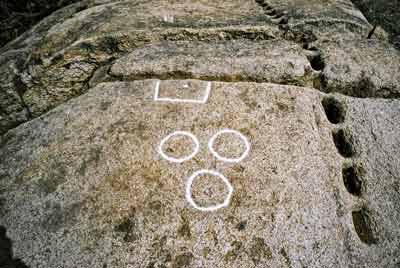
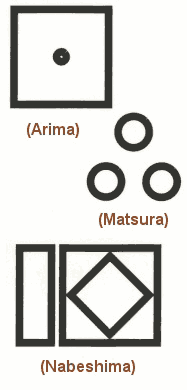
Kameiwa and Kabutoyama Quarries (Nishinomiya City, Hyōgo Prefecture) and incised seals This is a colossal stone 5.5 m east-west by 5.3 m north-south. Lines of holes for wedge-shaped tools (ya) remain, along with incised seals of the Matsura clan of the Hirado domain, and the Arima of Kurume. |

Stone carved with the character |
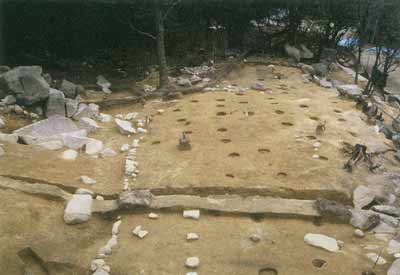
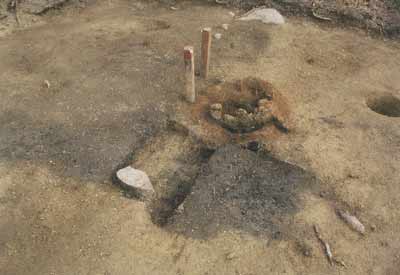
Remains of a building and hearth, Iwagahira Quarry Site (Ashiya City, Hyōgo Prefecture) These were discovered at the quarry site of the Terazawa clan of the Karatsu domain. The upper photo shows a simple embedded-pillar structure, possibly a barrack for quarry workers. The feature in the lower photo is thought to have been for repairing iron implements such as tools for quarrying. 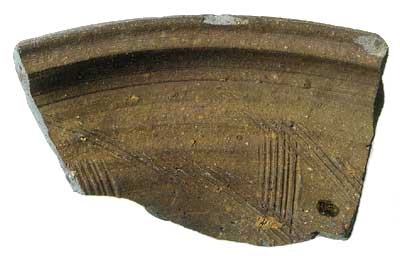
A recovered Bizen ware mortar |
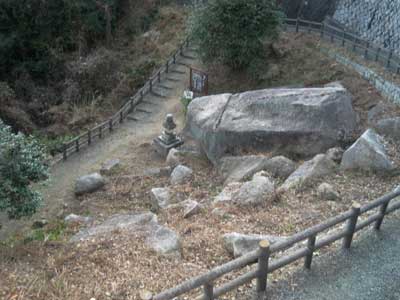 Hachinin Iwa Quarry Site, prepared for public presentation (Historic Site, Osaka Castle Wall Stone Quarry Remains, Shōdoshima Town, Kagawa Prefecture) |
Osaka Castle Wall Stone Quarry Remains. Nishinomiya/Ashiya Cities, Hyōgo Prefecture; Shōdoshima Town, Kagawa Prefecture; Karatsu City, Saga Prefecture.
Reconstruction of Osaka castle by the Edo shogunate
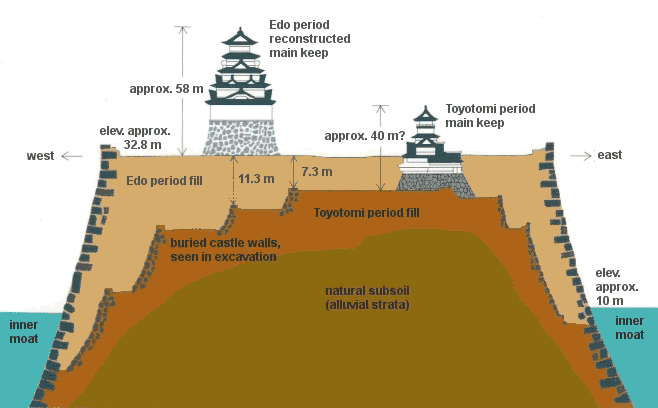
Cross-section of the reconstructed Osaka castle |
The construction extended more than a decade in three phases, with over 60 daimyo in the Tōhoku and the western regions of Japan dividing up the work of building the moats and stone walls. Nearly all of the daimyo participating were those who had received Toyotomi Hideyoshi's patronage. Ordering the construction work was intended to display the power of the shogunate, while at the same time diminish the economic might of these daimyo.
The archaeology of stone quarries

|
At these quarries, huge stones cut out at that time remain today. By investigating the locations of these quarries and the topography of the surrounding areas, the marks left by wedge-shaped tools called ya used when splitting the rock, and the distribution of detritus produced when the stones were dressed, it is possible to reconstruct the process from the quarrying to the processing, then the transporting of the stones. Further, among these stones are items bearing incised seals. These marks indicate the stones' ownership, and as daimyo participating in the construction used different characters and signs, through detailed analysis and examination of these it is possible to reveal whose quarry it was.
As research has been pursued from this approach at various quarry sites over recent years, the nature of Osaka castle's reconstruction has become clear archaeologically. Accordingly, through an introduction here of the results of investigations at various quarry sites for the stones of Osaka castle's walls, we can approach the actual conditions of a large-scale construction project conducted by order of the shogunate at the start of the Edo period.
Varieties of quarries
Among these quarries there are (1) sources of good quality granite that were apportioned among the daimyo by a specially appointed minister of the shogunate, and (2) those set up within their own domains by the daimyo charged with construction,. Daimyo themselves were responsible for securing, cutting, and transporting the stone from the quarries, plus the actual construction at the site.
These quarries were called by various combinations of the words ishikiri (stone cutting), and chōba (worksite) and their elements: ishikiri chōba, ishi chōba, or ishiba.
Among quarry sites, the largest in scale is in the Rokkō mountains, from where it is estimated that about one third of the stone used at Osaka castle was cut. Here a number of daimyo would use a single quarry in common. By contrast, for quarries on islands of the Inland Sea, it is known that daimyo such as the Katō clan of the Kumamoto domain or the Maeda of Kanazawa established quarries on their own.
Also, among quarries located within daimyos' domains there are Kasagi and Kamo in Kyoto prefecture (in Tōdō Takatora's domain), and Kutsuo in Fukuoka prefecture (in Hosokawa Tadaoki's domain). Records of the Tōdō domain relate that in 1620, Takatora himself stayed at Kamo and managed the quarrying.
For the Kutsuo quarry in Fukuoka, according to a letter addressed by Tadaoki to a retainer in Osaka, five huge stones cut from that location were sent to Osaka in 1620. Reaching Osaka after about a month's transport, they were used in the stone walls of the Inui turret. As the Hosokawa clan also held closer quarries on the Shōdoshima and Shiwaku islands, was the sending of stones all the way from the domain perhaps intended as a sign of its loyalty to the shogunate?
Conditions at a quarry
For daimyo, participating in the construction of Osaka castle was a perfect chance to demonstrate their loyalty to the shogunate and contribute to their own lines' security. For that reason they took up the construction work with all of their effort.
For example in the Tōdō domain three chief retainers were given comprehensive responsibility for the quarries, and the lord of the domain Takatora himself gave out detailed instructions. And in addition to dispatching many retainers to the sites, locally influential figures and artisans were mobilized and assigned to the quarrying and transport.
From documents handed down in the Hosokawa line, conditions at a quarry are learned more concretely. At the quarry sites, in addition to officials of the shogunate's minister and direct retainers, there were also senior and other high-ranking retainers of the Hosokawa sent to oversee the work. The latter had stern warnings from the Hosokawa to give the shogun's officers their complete obedience, and moreover allow no trouble with retainers of other clans to arise.
For the quarrying and transport, laborers were divided into work teams, with adjustments made so that the number of workers per team would stay in balance. Work evaluations were also made for each laborer individually, with reports surviving which note a person is "doing the best he can," and so forth.
It was under strict management such as this that work was conducted at the quarries in systematic fashion. From documents of the time we catch a glimpse of the task being handled as if organizing for battle.
What the quarries tell
While many documents relating the construction of Osaka castle survive, nearly all are records of the shogunate's orders, or writings passed down through daimyo lines, so it is not possible to know of the activities of other feudal lords, of greater or lesser standing, for whom no written materials survive.
One potent key for reconstructing the quarrying work of such various lords consists of the seals incised on the stones, introduced above.
For example, with regard to the quarry of the Terazawa clan of the Karatsu domain, since this line was divested of samurai status in1647 no historical documents as such survive, but stones with incised seals closely resembling the Terazawa family crest have been found at Iwagahira in Ashiya, Hyōgo prefecture. This discovery clarified the location of the Terazawa clan's quarry. Also, a building inferred to have been a lodging for people taking part in the quarrying, and a smith's forge where tools for use in the work are thought to have been made have been found, revealing the conditions of quarrying in concrete fashion.
It is not necessarily the case that all of the quarries for Osaka castle have been found. Unknown quarries not appearing in historic documents may still lie sleeping, from which new historic discoveries could come to light. (Ōmi Toshihide)
Higashi Rokkō Quarry Site, Nishinomiya City, Hyōgo Prefecture
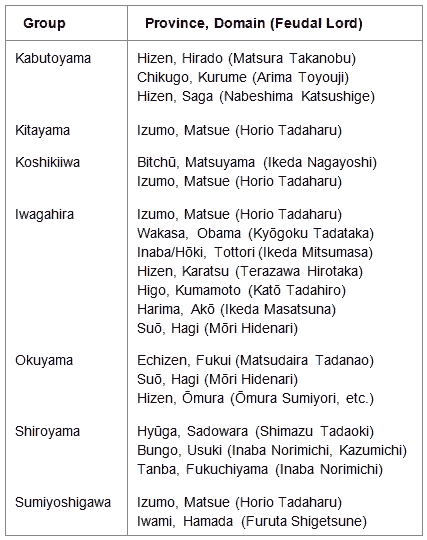
Incised Seal Groups at Higashi Rokkō Quarry |
Within the site the Kabutoyama incised seal group spreads over a hilly area approximately 1 km square. From comparisons of the incised seals left on stones at the quarry with those on the stone walls of Osaka castle and the daimyo involved in its construction, it is seen that the Matsura clan of the Hirado domain, Arima of Kurume, and Nabeshima of Saga used this area as a quarry. From records passed down in the Nabeshima line, this quarry was known as "Hirotayama." (Gōda Shigenobu)
Shiroyama/Okuyama/Iwagahira Quarry Sites, Ashiya City, Hyōgo Prefecture
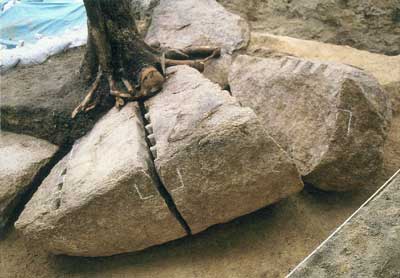
Stones found at the base of a mountain. Shiroyama Quarry Site (Ashiya City, Hyōgo Prefecture) Standardized construction stones were being cut like slices of jellied bean paste (yōkan). Approximate dimensions: length, 1.7 m; width, 2.7 m; height, 74 cm. |
Excavations have been actively conducted at Iwagahira, Shiroyama, and elsewhere from the 1990s, and at Iwagahira it was learned that quarrying was done cooperatively among daimyo such as Mōri, Kyōgoku, Ikeda, Horio, Terazawa, and Katō. The remains of a building with a smith's hearth were found, and items such as mortars of Bizen and Tanba ware, medal coins, bellows nozzles, slag, and smithing debris were recovered. Confirming various facilities of the quarry, and learning about one aspect of work associated with the quarrying process, are results of great importance. (Morioka Hideto)
Historic Site, Osaka Castle Wall Stone Quarry Remains (Hachinin Iwa, Tōfu Iwa, Tengu Iwa, Tengu Iwa Iso, Kamezaki, Minamidani Quarries), Shōdoshima Town, Kagawa Prefecture
 Plentiful traces remain of quarrying stones for the reconstruction of Osaka castle (Historic Site, Osaka Castle Wall Stone Quarry Remains: Minamidani Quarry, Shōdoshima Town, Kagawa Prefecture) |
There are several other quarries on the island, and according to records the Hosokawa clan of the Kokura domain, and the Tōdō of the Tsu domain and others quarried stone from the island. The Hosokawa also had quarries on islands other than Shōdoshima. Stone was probably thus taken from islands of the Inland Sea because of suitability for transport. (Azuma Nobuo)
Taniguchi Quarry Site, Karatsu City, Saga Prefecture

Dressed stone remaining at the summit of Mt. Kuroda. Taniguchi Quarry Site (Karatsu City, Saga Prefecture) |
Adapted from Hakkutsu sareta Nihon rettō 2011 [Excavations in the Japanese Archipelago, 2011] (Bunkachō [Agency for Cultural Affairs], ed., Asahi Shimbun Publications, 2011).
